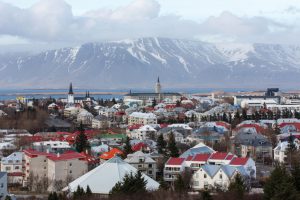BLOOMBERG
Beneath the road on a snow-dusted mountain in the Hellisheiði region of southwest Iceland, a river of boiling water flows through porous, volcanic rock. Above, thick steel pipes connect to geodesic domes, each of which houses a geothermal well.
Steinþór NÃelsson, a senior geologist with ISOR (Iceland Geosurvey), parks his car near one of the rounded huts. He and his team analyse rock samples taken from boreholes to figure out the best way to drill, and then track how the supply of hot water is affected by tapping its steam, which is used to create electricity for this area, as well as the capital of Reykjavik.
Formed 60 million years ago, Iceland is the youngest country on earth, and it’s still growing. The North American and Eurasian tectonic plates form a thick seam up the Arctic country that’s pulling apart, releasing fresh magma one ripped stitch at a time. The repercussions are epic: volcanic eruptions, earthquakes and a massive geothermal resource that, over the past century, has transformed Iceland from impoverished nation to the 15th richest country in the world. While the rest of Europe worries about turning down the heat or turning back to coal, Icelanders enjoy risibly low energy bills and an enviable quality of life, thanks to an abundance of water, most of which is scalding hot.
Today, every home in Iceland is heated with renewable energy: 90% from district heating systems that tap hot water directly underground and 10% from electricity generated either using steam from that water or hydropower. One-hundred percent of the country’s electricity is also renewable.
It’s taken almost a century, but the country has managed to maximise the social benefits of renewable energy, as well as the economic and environmental ones. Once thick with smog, the air over Reykjavik is now crystal clear. Homes are toasty, heated by naturally boiling water that’s also used to warm the multitude of outdoor swimming pools Icelanders consider an essential resource during the cold, dark winters.
Twenty-five percent of Europeans live in areas that could benefit from geothermal power, says Jack Kiruja, a geothermal analyst with the International Renewable Energy Agency. But while more countries are following Iceland’s lead, none have been as successful in fully exploiting their geothermal resources, he says. Iceland has clear geothermal regulations, policies that reduce the economic risk of drilling and robust training programs to build technical expertise.
Most importantly, it is laser-focused on finding ways to leverage its geothermal resources. All of this means a typical Icelandic geothermal power station can create more jobs, per-capita GDP, and socioeconomic benefits, he says. “Countries need to focus not just on the electricity made from the geothermal, but also the other alternative resource uses that they can derive.â€
Iceland’s energy transition began almost a century ago, during a period that has parallels to today. Amidst heightened European tensions, a global Depression, and rising energy insecurity, officials made the risky decision to wean the capital off coal by tapping geothermal.
Today, the country’s biggest challenge is its success. As the rest of the world looks to decarbonise, interest from foreign companies keen to set up operations in Iceland for cheap, renewable power far exceeds the country’s current capacity.
“This is the only time in the history of Iceland that foreign investment is knocking at our door. We have usually been knocking at their door,†says Guðlaugur Þór Þórðarson, Minister of the Environment, Energy and Climate. “Most of them are looking for the same thing: green energy. And it’s obvious that we cannot fulfill everyone’s needs. We need to pick and choose.â€
Data centers have been particularly interested in staunching their vast energy needs cheaply (not to mention in a climate where servers can be cooled by simply opening the windows). The country has accepted some, but not all, of the requests but that’s still been enough to cause some friction.
Clean-tech startup Alor, which is working on an aluminum-ion battery, is hoping to begin production in 2024. It had planned to manufacture in Iceland but is having second thoughts because of fear it won’t be able to secure an energy contract.
Inside the Ministry of the Environment, Energy and Climate, in Reykjavik, Þórðarson keeps an original poster from the 1938 municipal election on his office wall. “Vote Geothermal†it urged Icelanders, as part of a PR campaign that promised hot water in kitchens, fresh produce and the end of smog.
 The Gulf Time Newspaper One of the finest business newspapers in the UAE brought to you by our professional writers and editors.
The Gulf Time Newspaper One of the finest business newspapers in the UAE brought to you by our professional writers and editors.
